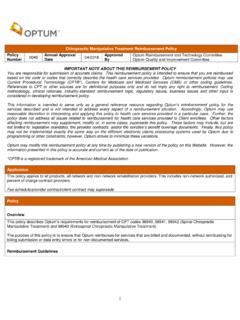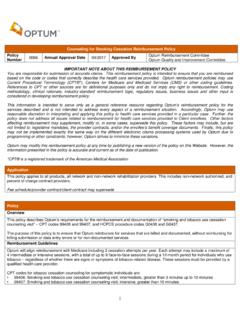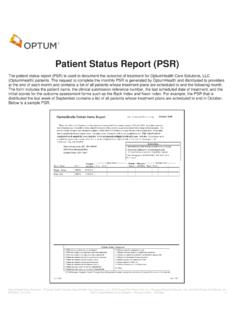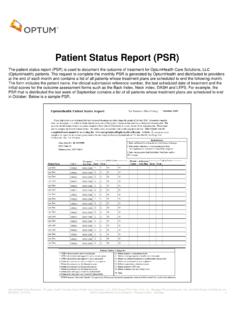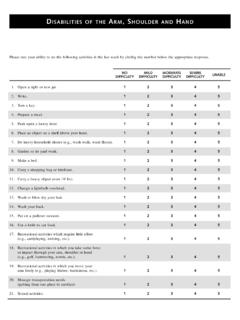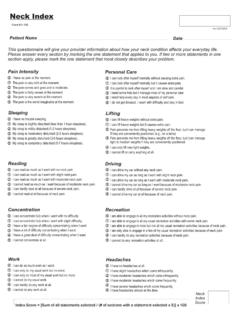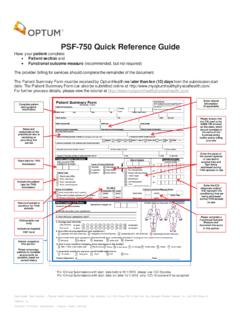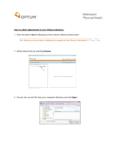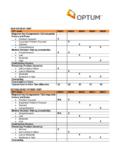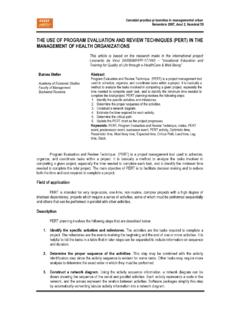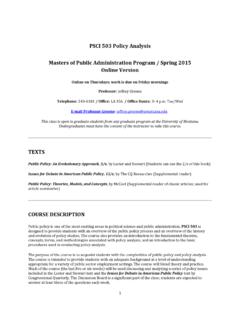Transcription of Patient Healthcare Records: Documentation Requirements …
1 utilization management Policy *Optum is a brand used by OptumHealth Care Solutions, LLC and its affiliates 1 Patient Healthcare Records: Documentation Requirements for utilization Review and File Audits Table of Contents Related Policies Policy Number 474 Policy 1 2 2 2 2 3 5 Determination of Maximum Therapeutic Benefit Reporting Spinal Chiropractic Manipulative (CMT) Levels Patient Records Retrospective Clinical Review (Post-Service) Original Effective Date: Current Approval Date: Next Review: Category: 7/2008 4/26/18 4/2019 Determination Policy Statement The following are required components of Patient medical record Documentation : The reason for the encounter , presenting complaint(s) The patients prior medical, familial and social history.
2 This includes but is not limited to accidents, surgeries, medications, illnesses and co-morbidities. Systems review consistent with the nature of complaint(s) and relevant historical information Pertinent reports and tests that were reviewed or ordered The working diagnosis(es) must be documented and consistent with the associated findings A treatment plan must be included that describes the plan of care consistent with the natural history, findings and diagnosis of the Patient Contraindications to care must be listed with an explanation of their current management All entries to the daily medical record must be dated and authenticated. Authentication will include at least the provider's initials. In those circumstances where the provider s qualifications to render the services must be established, authentication must include the provider's full name and appropriate designation.
3 File records must be organized and legible to those other than the author. When symbols or abbreviations are used, a key that explains their meaning must accompany the file. Records must be in chronological order and written in permanent ink. The Documentation for each date of service must include the date, subjective complaint(s), objective findings, assessment, diagnostic impression, therapeutic intervention(s), recommendations instructions given to the Patient and a treatment plan. Services must be documented in accordance with Current Procedural Terminology (CPT) coding criteria , location (body region), time component, etc. Each Patient record must identify the Patient and each page in the medical record must contain the Patient s name or identification number.
4 Any corrections to the Patient s record must be made legibly in ink and authenticated by the person making the correction(s). The Patient record must include periodic measures of treatment response Discharge status including the current functional status, degree of goal attainment, home program given, referral or follow up, family instruction, equipment given, and reason for discharge. utilization management Policy *Optum is a brand used by OptumHealth Care Solutions, LLC and its affiliates 2 The following Documentation should be included in the Patient s medical record : 1. Each Patient file should include the Patient s date of birth, occupation, and appropriate contact information 2. Daily notes should be in a standard type format SOAP/SOP and contain the date for return visits or a follow-up plan 3.
5 Explicit treatment goals (functional/measurable/with a time component) should be included in chart records where the course of care is likely to extend >2 weeks 4. The Patient record should include valid, reliable and relevant outcome assessment tools, ensuring that a peer reviewer or other Healthcare professionals can render a reasonable determination on the baseline status and treatment response. 5. Adverse events associated with treatment should be recorded in the Patient chart Purpose This policy describes the elements of Documentation that Healthcare providers are required to include in Patient medical records as well as recommended elements. Summary There is a large body of evidence supporting common minimal Documentation standards across physical medicine disciplines established by regulatory entities.
6 Many state and national professional societies have published in-depth documents designed to inform health care providers of their ethical and legal responsibilities/risks beyond these minimum standards. These same documents provide templates to facilitate adherence to record keeping standards. Other Healthcare organizations have published policies, positions and/or reports on record keeping standards for physical medicine disciplines. These standards can and are applied to utilization review programs by third party payers. Scope This policy applies to all products and all network and non-network providers of physical medicine services where utilization review and/or file audits are conducted. Background Patient chart records serve as an historical account of Patient /provider encounters.
7 record keeping is an essential component of quality-focused Patient management . Good Healthcare decision-making is dependent upon a practitioner s ability to retrieve accurate and complete facts from the Patient s records.[1] In addition to providing a basis for clinical decision-making, Patient chart records are used to document procedures performed, Patient response to care, assure for the smooth transition of care, and may be used by third-party payers as the standard to determine appropriate/necessary service utilization . utilization management Policy *Optum is a brand used by OptumHealth Care Solutions, LLC and its affiliates 3 Professional licensing boards and/or state-specific statutes have established minimal standards/ Requirements for record keeping by health care professionals including chiropractors, physical and occupational therapists.
8 [2-27] Common elements cited by these regulations include: o Date (of each entry) o Legibility (possible to read and decipher) o Interpretable (by third parties , other health care providers, payers) o Timeliness (recorded at the time of each visit) o Patient demographic information o Problem list (symptoms/conditions) o Patient histories (personal, family) o Examination/evaluation/re-evaluation findings o Diagnosis/assessment (including working diagnoses) o Plan of care (interventions, self-care, goals) o Response to treatment (outcomes assessment) o Written reports and correspondence (sent and received) o Authentication (identification of the chart note author) Regulatory standards typically apply to all licensed professionals during the normal course of care independent of renumeration, , regardless of whether the fee for services was charged, reduced, or waived by means of advertisement or otherwise.
9 In addition to commonly sourced minimum record keeping standards, several regulatory oversight entities have described these elements in detail.[1,5,16,22] Similarly, professional organizations have developed more expansive Documentation standards and/or recommendations.[28,29] These manuals typically provide an evidence basis supporting the, consistency, content and quality of record keeping, as well as offering templated formats. Other health care organizations and authoritative sources have rendered commentary, reports, and/or enunciated positions/policies concerning standards for record keeping.[28-43] While some of these reports and texts focus upon deficiencies in record keeping, they all describe similar minimum Documentation standards.
10 In addition to these topics, some organizations have established policies or positions that impact utilization review and file audits , services billed should be described in the Patient chart in accordance with Current Procedural Terminology (CPT) coding criteria [44]; and billed services, which are not documented in the Patient health care record , are not eligible for reimbursement. References 1. Educational manual for evidence-based chiropractic: chapter 3. Oregon Board of Chiropractic Examiners. July 20, 2006; Accessed 2/16/16: 2. Arizona Board of Physical Therapy. accessed 2/16/16: 3. Lang MG, et al. record keeping and report writing. Oregon Board of Chiropractic Examiners Oregon Chiropractic Practices and utilization Guidelines Committee.
